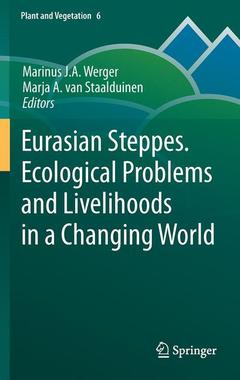Description
Eurasian Steppes. Ecological Problems and Livelihoods in a Changing World, 2012
Plant and Vegetation Series, Vol. 6
Coordinators: Werger Marinus J.A., van Staalduinen Marja A.
Language: English
Subjects for Eurasian Steppes. Ecological Problems and Livelihoods in...:
Publication date: 06-2014
568 p. · 15.5x23.5 cm · Paperback
Publication date: 05-2012
568 p. · 15.5x23.5 cm · Paperback
Description
/li>Contents
/li>Comment
/li>
Steppes form one of the largest biomes. Drastic changes in steppe ecology, land use and livelihoods came with the emergence, and again with the collapse, of communist states. Excessive ploughing and vast influx of people into the steppe zone led to a strong decline in nomadic pastoralism in the Soviet Union and China and in severely degraded steppe ecosystems. In Mongolia nomadic pastoralism persisted, but steppes degraded because of strongly increased livestock loads. After the Soviet collapse steppes regenerated on huge tracts of fallow land. Presently, new, restorative steppe land management schemes are applied. On top of all these changes come strong effects of climate change in the northern part of the steppe zone. This book gives an up-to-date overview of changes in ecology, climate and use of the entire Eurasian steppe area and their effects on livelihoods of steppe people. It integrates knowledge that so far was available only in a spectrum of locally used languages.
Preface.- Authors and Affiliations.- 1. Abiotic and biotic determinants of Steppe Productivity and Performance – a view from Central Asia.- 2. The Steppe Biome in Russia: Ecosystem Services, Conservation Status, and Actual Challenges.- 3. Steppes of Kazakhstan: Diversity and present State.- 4. The Central Anatolian Steppe.- 5. Ukrainian Steppes in the past, at present and in the future.- 6. Cessation of Traditional Management reduces the Diversity of Steppe-like Grasslands in Romania through litter accumulation.- 7. Past trends, present state and future prospects of Hungarian Forest-Steppes.- 8. The dry Grasslands in Slovakia: history, classification and managemen.- 9. Iberian steppes.- 10. Pastoral Degradation of Steppe ecosystems in Central Mongolia.- 11. Plant Functional Types across Dune Fixation Stages in the Chinese Steppe zone and their applicability for Restoration of the Desertified Land.- 12. Population Dynamics of a Key Steppe Species in a Changing World: the critically endangered Saiga Antelope.- 13. The Przewalski’s horse and its reintroduction in the steppe of Hustai National Park, Mongolia.- 14. Transformation of Steppe communities of Yakutia due to Climatic Change and Anthropogenic Impact.- 15. Influence of Climate Change on Vegetation and Wildlife in the Daurian eco-region.- 16. Changes in the southern Siberian Forest-Steppes.- 17. Effects of Climate Warming and Vegetation cover on Permafrost of Mongolia.- 18. Degradation and Management of Steppes in China.- 19. Land Use Modernization and Agrarian and Conservation prospects in the Russian Steppe.- 20. Rethinking Pastoral Risk Management in Mongolia.- 21. Mongolian Nomads and Climate Change – a herder’s view.




